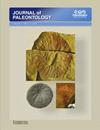中新世而非侏罗纪:良好的实地调查对古生物数据分析的重要性
IF 1.6
4区 地球科学
Q3 PALEONTOLOGY
引用次数: 2
摘要
摘要在印度西部的Kachchh发现的一个以turritellid腹足类为主的多样化软体动物群落,在过去被解释为侏罗纪晚期(牛津阶),其年龄无疑是基于相关的牛津阶菊石。最近,一些研究集中在该组合的分类学、古生态学和进化方面。对相关双壳动物群、有孔虫组合和地质背景的分析有力地表明了中新世而非侏罗纪,并使从化石的侏罗纪时代得出的几个结论无效。本文章由计算机程序翻译,如有差异,请以英文原文为准。
Miocene instead of Jurassic: the importance of sound fieldwork for paleontological data analysis
Abstract. A diverse molluscan assemblage dominated by turritellid gastropods found in Kachchh, western India, has been interpreted in the past as Late Jurassic (Oxfordian) in age, based on associated undoubtedly Oxfordian ammonites. Recently, several investigations focused on the assemblage dealing with taxonomic, paleoecological, and evolutionary aspects. An analysis of the associated bivalve fauna, foraminiferal assemblage, and the geological context strongly suggests a Miocene rather than a Jurassic age and invalidates several conclusions drawn from the alleged Jurassic age of the fossils.
求助全文
通过发布文献求助,成功后即可免费获取论文全文。
去求助
来源期刊

Journal of Paleontology
地学-古生物学
CiteScore
2.80
自引率
7.10%
发文量
94
审稿时长
6-12 weeks
期刊介绍:
The Journal of Paleontology publishes original articles and notes on the systematics, phylogeny, paleoecology, paleogeography, and evolution of fossil organisms. It emphasizes specimen-based research and features high quality illustrations. All taxonomic groups are treated, including invertebrates, microfossils, plants, vertebrates, and ichnofossils.
 求助内容:
求助内容: 应助结果提醒方式:
应助结果提醒方式:


